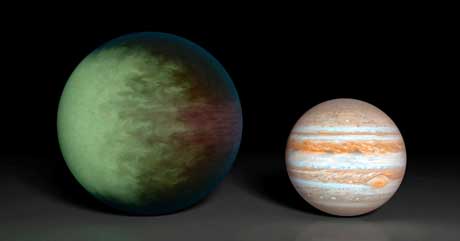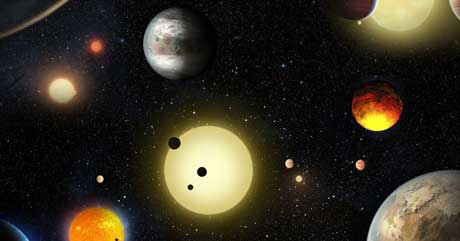Far from the solar system Kepler is finding a variety of planets and satellites. Launched March 6, 2009, success has come quickly to the mission. The Kepler space telescope is only a fraction the size of the Hubble, but its mission is much more specific and not intended to produce the spectacular images of Hubble. Kepler has a heliocentric — sun-centered — orbit following the Earth around the sun. It is far beyond the atmosphere of the Earth at a distance of 1 AU — about 93 million miles — and falling slowly behind the earth.
Kepler Looks at a Special Place in a Special Way

Kepler’s mission is to study a sector of the Milky Way galaxy with about 150,000 stars in its field of view. It does not take pictures of planets, but uses a light-sensing device known as a photometer to detect slight variations in the light emitted by stars as planets orbit in front of them. The planets block a small amount of light from the star, and these small variations in brightness can be detected by Kepler’s sensitive instruments.
The amount of variation gives an indication of the size of the planet. The stars discovered with tell-tell variations are observed from Earth with larger telescopes for spectroscopic analysis which yields information about the location of the planet relative to its star as well as its density and mass, source.
Assumptions can be made about the chance of life on the planets. Kepler attempts to locate planets in the “habitable zone,” also called the Goldilocks Zone. This refers to a location and orbital shape that is “just right” for the existence of life as we know it.
New Announcements from the Kepler Team Confirms its Success
On December 5, 2011, the Kepler team announced that the mission has isolated one planet that was enough like Earth to possibly support life. The evidence is indirect and open to interpretation, but the mission has been an astounding success. Only decades ago the idea of gathering detailed information on planets light years away seemed dim.
The planet — Kepler 22b — is 600 light years away and seems to be about the right size and temperature with a decent orbit and atmosphere. In other words, it is in the Goldilocks Zone. Kepler 22b has been studied for two years to gather data. Over 1,000 planets have been added to its previous discoveries bringing the total to over 2,000 since the mission began.
There are 207 planets that are approximately Earth-sized. Multiple planets have been discovered sharing a single star — in other words, solar systems. The mission will continue for another year and undoubtedly add to the list of known exoplanets.

The Kepler space telescope was launched in 2009. Since then its instruments have scanned over 150,000 stars and picked out over 2,000 planets and moons orbiting stars hundreds of light years away. No pictures are available as the techniques involved were based on slight variations in the light of stars as planets passed in front of them. Additional information was gathered by earth-based analysis of light. The most promising candidate for possible life so far — Kepler 22b — was announced on December 5, 2011.